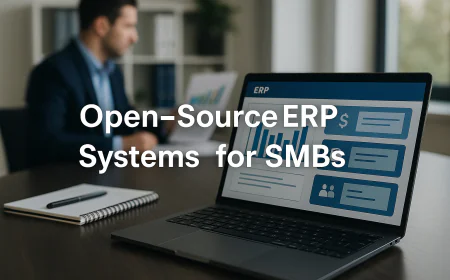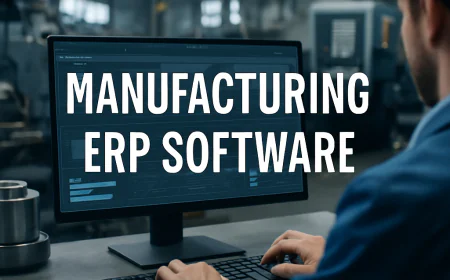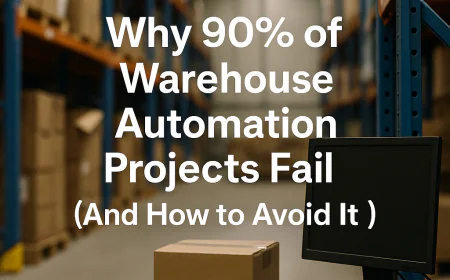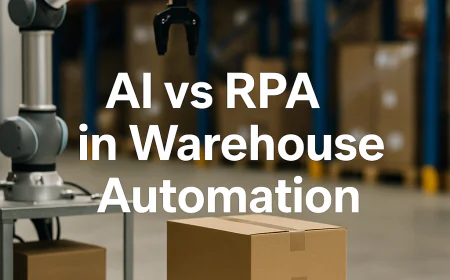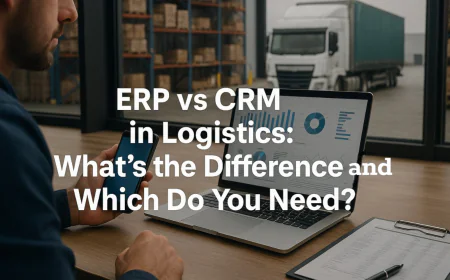Why 90% of Warehouse Automation Projects Fail (And How to Avoid It)
Most warehouse automation fails within 2 years. Learn the hidden reasons behind it — and how to design a system that lasts.
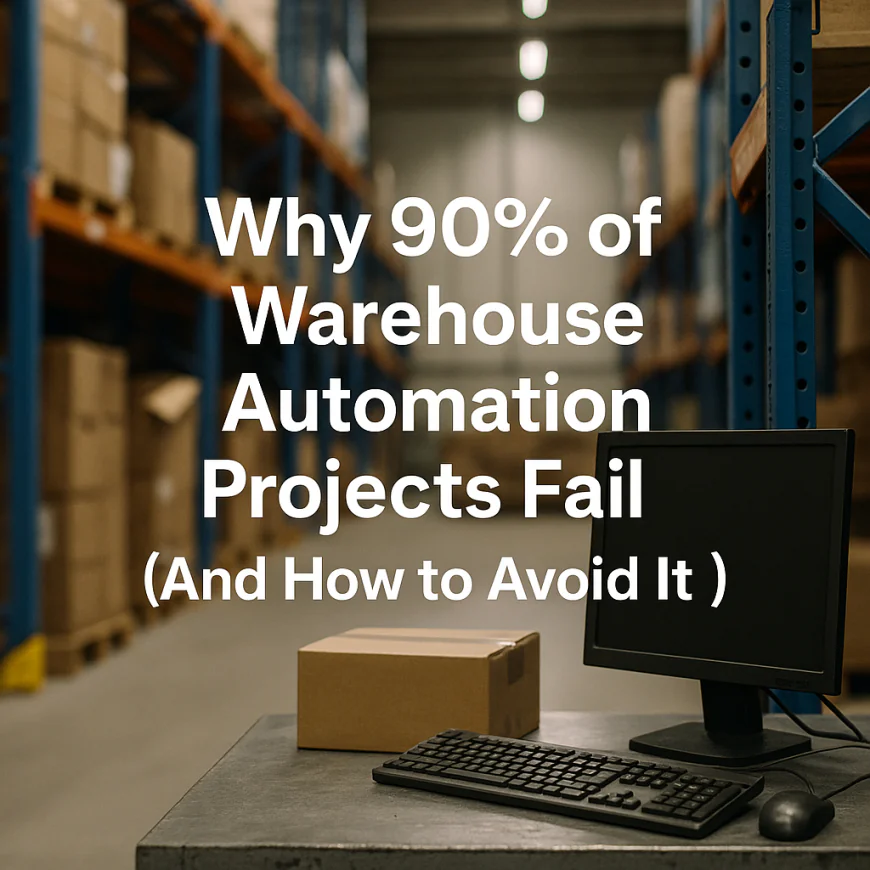
Warehouse automation promises speed, efficiency, and reduced labor costs — but most companies never see those benefits. In fact, 90% of warehouse automation projects fail to deliver ROI within two years, and many collapse before reaching full deployment.
Why? Because businesses rush into automation with unrealistic expectations, poor planning, or technology that doesn’t match real-world operations. This guide breaks down the true reasons behind these failures — and shows you how to succeed where others fail.
While AI promises major efficiency gains, it’s often rolled out too early. See our deep dive on AI vs RPA in warehouse automation
And now lets start..
1. What causes most warehouse automation projects to fail early?
Poor process mapping before automation
Many companies try to automate broken processes instead of fixing them first. If your workflows are inefficient, automation will just accelerate the chaos.
Hack: Do a full process audit with frontline workers before talking to vendors. Use tools like Lucidchart or Miro to map out daily workflows.
Vendor overpromising and underdelivering
Some vendors sell a vision that looks amazing in demos — but it falls apart in real operations. You might get locked into proprietary hardware or software that can’t scale or integrate with your WMS or ERP.
Hack: Always request live sandbox testing in your environment, not a controlled demo. And get a written clause for post-deployment support SLAs.
No cross-functional team leading the project
Automation isn’t just an IT or ops issue. When departments don’t collaborate, gaps form — and no one owns the failure.
Hack: Form a task force with members from ops, IT, finance, and warehouse floor leaders. Rotate a project champion monthly to maintain momentum.
Lack of scalability planning
It’s common to automate a single task (like picking or inventory) and find out later that scaling requires a complete rebuild.
Hack: Always ask: “If we grow 5x, will this setup still work?” If not, don’t commit.
Inaccurate ROI projections
Vendors often oversell cost savings — and companies ignore indirect costs like training, downtime, or ongoing maintenance.
Hack: Build your own ROI calculator with worst-case inputs. Include staff overtime, third-party support, retraining, and software updates. Then compare that to vendor estimates.
2. What role does technology mismatch play in failed automation?
Trying to automate too much, too fast
One of the most common traps: going all-in with robotics, AI, and IoT at the same time. Complex tech layers that aren't fully understood lead to integration chaos.
Hack: Follow the “Crawl-Walk-Run” approach. Start with low-risk automation like barcode scanning or automated sorting, then expand only after performance validation.
Choosing tech that doesn’t fit your warehouse layout
Many tools are designed for ideal, grid-style layouts — but real warehouses are messy. If your aisles, racking, or SKUs don’t fit vendor assumptions, tech can slow you down.
Hack: Use 3D simulation tools (like AnyLogic or FlexSim) before buying anything. Simulate your current layout with the proposed tech stack and measure bottlenecks.
Ignoring software interoperability
You might implement a powerful robot or automation tool, but if it doesn’t talk to your ERP, WMS, or TMS, the data chaos will kill your efficiency.
Hack: Ask every vendor, “What systems do you natively integrate with?” Then confirm with your IT team that these systems will work out of the box — no custom APIs required.
Over-reliance on proprietary platforms
Some vendors lock you into ecosystems that prevent modular upgrades later. That means you’ll have to reinvest completely when you grow or pivot.
Hack: Prioritize vendors with open architecture and strong API documentation. Ask for use cases where third-party systems were integrated easily.
Underestimating the need for real-time data
Automation works only as well as the data feeding it. If your sensors, inventory counts, or scanning processes aren’t real-time, your automated system will act on stale or wrong inputs.
Hack: Invest early in real-time location systems (RTLS) and smart labeling systems. These feed clean data to downstream tools like AI engines or robotic arms.
3. Why are people and culture the hidden reasons most automation fails?
Fear of being replaced
Warehouse workers often see automation as a threat to their jobs. This leads to passive resistance, errors, or even sabotage. The best tech in the world can’t overcome human pushback.
Hack: Rebrand automation as “assistive tech” during internal rollouts. Position tools as ways to remove boring, repetitive tasks — not cut jobs.
Lack of change management
Companies drop automation tools into warehouses with zero training or behavior planning. The result? Confusion, misuse, or outright failure.
Hack: Treat warehouse automation like an HR project as much as an IT one. Build a change plan that includes communication, champions, training, and feedback loops.
No incentives for adoption
Managers want KPIs. Workers want job security. If no one is incentivized to make the automation work, it’ll quietly be ignored or underused.
Hack: Introduce gamified adoption metrics — e.g., bonuses for uptime, successful robot collaboration, or reduced errors. Show workers how their future pay depends on success.
Overlooking tribal knowledge
Veteran warehouse staff often know “unwritten rules” that aren’t documented — like shortcuts, danger zones, or maintenance hacks. Automation ignores this nuance and fails.
Hack: Do pre-automation interviews with key staff. Ask: “What do machines or engineers never notice here?” Use these insights in your design.
Managers don’t trust AI decisions
Even if the automation is technically correct, managers often reject what they don’t understand — especially with black-box AI.
Hack: Use human-in-the-loop AI systems. Let managers override AI decisions during phase one. Trust builds when AI proves consistent, not just fast.
4. Why do poor data and planning destroy automation before it even launches?
Garbage in, garbage out: Dirty data ruins automation logic
Automation relies on structured, reliable data. But most warehouses operate with inconsistent SKU naming, inaccurate stock levels, and manual workarounds. When this data feeds your robots, AI, or picking systems, failure is inevitable.
Hack: Before launching automation, conduct a deep data audit. Standardize SKU formats, barcode rules, and inventory thresholds. Use data validation scripts or AI-based anomaly detection to flag inconsistency patterns in real-time.
No master data governance
Warehouses often have product data spread across WMS, Excel sheets, ERP, and supplier portals — all slightly different. The automation stack won’t know which “truth” to follow.
Hack: Implement a single-source-of-truth approach with strict field validation. Use a centralized Product Information Management (PIM) system or enforce tight ERP-WMS synchronization.
Failure to simulate edge cases
Most businesses only test automation on perfect scenarios: average order sizes, common SKUs, normal traffic hours. But warehouse operations are messy — surges, returns, broken items, and unexpected layouts all stress the system.
Hack: Stress-test with edge-case simulation tools. Load in rare SKU sizes, forklift obstructions, blocked paths, and simultaneous high-volume orders. Use software like AnyLogic or even Unity 3D to model chaos.
Unrealistic project timelines
Executives often demand automation results in months, not years. This rush forces teams to deploy half-baked integrations with workarounds and no documentation. These shortcuts haunt you for years.
Hack: Create a milestone-based roadmap where every phase is tied to KPIs — not dates. Define “done” as passing operational tests, not hitting calendar deadlines. Communicate this to leadership to set expectations early.
No rollback or disaster recovery plan
What if the automation fails on Day 1? Many warehouses have no contingency plan, forcing teams into chaos. This erodes trust and causes costly delays.
Hack: Design hybrid fallback paths where every automated action has a manual override. Train staff on both modes. Run weekly drills where the automation system is “killed” and teams must continue operations seamlessly.
5.What happens when automation doesn’t align with business goals?
Automation that doesn’t support strategy is just expensive machinery
Many companies implement automation to look modern or reduce headcount — but if the system doesn’t actually support faster shipping, higher accuracy, or lower costs (depending on the business goal), it becomes a distraction. For example, installing autonomous robots in a warehouse focused on same-day delivery might slow things down if they can't handle peak surges.
Hack: Tie every automation feature to a business outcome. If your goal is to reduce picking time by 40%, make sure the system is measured against that — not vague metrics like "operational efficiency."
Failure to account for customer experience metrics
Automation might increase throughput but reduce order accuracy or flexibility. That’s a problem if your brand promise is built around customization or personal service.
Hack: Include customer impact metrics (like return rate or complaint rate) in your automation dashboards. Use those to decide whether automation is working — not just internal warehouse KPIs.
6.Why scaling automation is harder than starting it
Initial success doesn’t guarantee scalability
Many projects perform well during pilots or in one facility, but fail when rolled out across multiple warehouses. That’s because layout differences, staff skill levels, and local workflows all vary — and automation systems don’t always adapt.
Hack: Treat scale as a new project. Don’t assume what worked in Warehouse A will work in B or C. Redesign and test for each rollout, especially with robotics or AI.
Software and infrastructure bottlenecks emerge late
At small scale, most systems run fine. But when scaled, data syncing delays, API limitations, or inventory mismatches appear — especially when integrating WMS, ERP, and robot control software.
Hack: Stress-test your entire stack in a virtual environment. Simulate 10x load, 100x SKUs, and off-hour disruptions to see what breaks under pressure.
Scaling adds invisible labor costs
Even automated systems need human oversight — especially when scaled. You’ll need more engineers, maintenance staff, and system admins. These costs are often not budgeted early.
Hack: Include human-in-the-loop architecture from day one. Design systems that alert humans only when needed, but allow rapid overrides and adjustments.
7.What critical KPIs get ignored until it's too late?
No one tracks ‘exceptions’ per hour
Automation often succeeds on averages — but fails on outliers. Rare SKUs, returns, oversized boxes, or unexpected orders can completely halt a workflow if not tracked.
Hack: Monitor exception frequency — how often humans must intervene, fix an error, or reroute a package. If that number creeps up, your system is degrading.
Maintenance downtime is underestimated
Vendors will tell you “99% uptime,” but they rarely include battery swaps, camera recalibration, sensor failures, or software updates. That downtime adds up quickly.
Hack: Track Mean Time Between Failures (MTBF) and Mean Time to Recovery (MTTR). These metrics tell you how reliable your system is in real life, not in vendor decks.
Staff productivity post-automation is rarely measured
Warehouses assume that automation will reduce labor needs — but often, it just shifts the labor. If workers become idle, frustrated, or undertrained, your system is quietly failing.
Hack: Measure human-machine interaction rates. Are humans waiting for robots, or vice versa? Who is idle? Who’s overwhelmed? Use this to rebalance workflows.
8.How to choose the right vendors (and not get locked in)
Vendor lock-in kills flexibility
Many automation vendors use proprietary hardware, software, and data formats. That means you can’t upgrade one component without replacing the whole system — expensive and risky.
Hack: Choose vendors that support open standards, API integrations, and modular hardware. Ask: “Can I switch out this robot arm without replacing my WMS?”
Overpromising during demos is common
Demos are often choreographed in ideal conditions. They don’t show how systems handle dirty floors, unexpected returns, or inconsistent lighting — all common in real warehouses.
Hack: Ask for a demo in your warehouse, with your data, and your toughest scenarios. Or require a paid proof-of-concept phase with defined success metrics.
No clear roadmap for upgrades or support
Many vendors can’t explain how their product evolves. That means your system could be outdated within a year — especially in AI-based automation where models improve constantly.
Hack: Ask for their release roadmap, versioning policy, and how updates are deployed. Also, confirm SLA terms for emergency support and on-site service.
9.What does a successful warehouse automation blueprint look like?
Phased implementation — not a single “go live”
Success comes from iterative rollouts. Start with one workflow (e.g., picking), refine it, then move to packing, loading, or putaway. Full automation on Day 1 is a recipe for disaster.
Hack: Use the 80/20 rule. Automate the 20% of workflows that cause 80% of delays first. Let the rest run manually until you prove ROI.
Cross-functional automation team
Automation can’t be led by just IT or just operations. It needs a team with warehouse managers, engineers, data analysts, and vendors all at the table.
Hack: Assign one automation champion in each department. Let them own communication and implementation across teams.
Built-in feedback loops
The best systems learn from themselves. Exception logs, downtime reports, and human feedback should feed back into updates and process tweaks.
Hack: Review automation performance weekly, not quarterly. Look at failure logs, floor-level feedback, and deviation reports in a shared dashboard.
10.How can you future-proof your automation investment?
Avoiding point solutions
Many companies automate one narrow workflow — like carton sealing — with highly specific machines. But if that vendor disappears or upgrades, your entire workflow is stranded.
Hack: Choose automation platforms that are modular and vendor-agnostic. Think Lego bricks, not single-use gadgets.
Designing for adaptability
Your SKU mix, order volume, and customer behavior will change over time. Rigid systems that can’t adapt will choke your growth.
Hack: Build flexibility into layouts. Use mobile racking, easily reprogrammable bots, and dynamic routing logic. Assume change from Day 1.
Training for long-term resilience
If only one engineer understands the system, you’re one resignation away from failure. You need institutional knowledge embedded across roles.
Hack: Document everything. Build internal certification programs. Let operators simulate failures and fixes regularly — like fire drills.
What's Your Reaction?
 Like
0
Like
0
 Dislike
0
Dislike
0
 Love
0
Love
0
 Funny
0
Funny
0
 Angry
0
Angry
0
 Sad
0
Sad
0
 Wow
0
Wow
0







